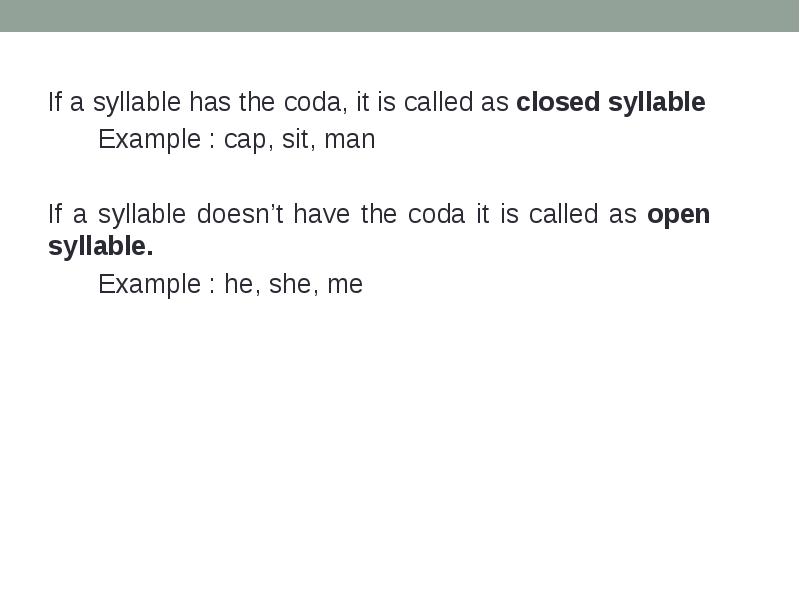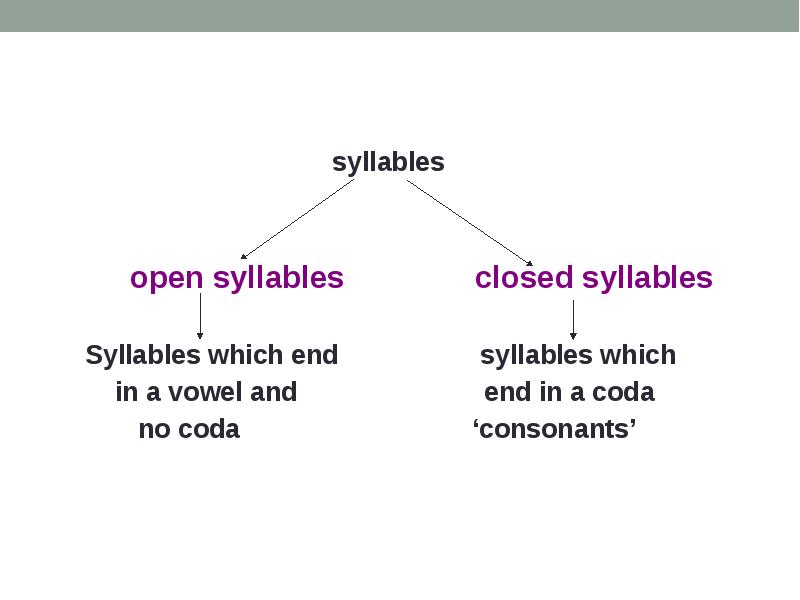Готовые презентации на тему:
- Образование
- Искусство и Фото
- Наши презентации
- Авто/мото
- Технологии
- Бизнес и предпринимательство
- Карьера
- Данные и аналитика
- Дизайн
- Устройства и комплектующие
- Экономика и Финансы
- Машиностроение
- Развлечения и Юмор
- Путешествия
- Eда
- Политика
- Юриспруденция
- Здоровье и Медицина
- Интернет
- Инвестиции
- Закон
- Стиль жизни
- Маркетинг
- Мобильные технологии
- Новости
- Недвижимость
- Рекрутинг
- Розничная торговля
- Таможня, ВЭД, Логистика
- Наука
- Услуги
- Программное обеспечение
- Спорт
- Музыка
- Шаблоны презентации
- Детские презентации
- Английский язык
- Астрономия
- Алгебра
- Биология
- География
- Геометрия
- История
- Литература
- Информатика
- Математика
- Обществознание
- Русский язык
- Физика
- Философия
- Химия
- МХК
- ОБЖ
- Окружающий мир
- Педагогика
- Технология
- Начальная школа
- Раскраски для детей
- Товароведение
- Менеджмент
- Страхование





![Onset (O)
Onset: the beginning sounds of the syllable; the ones preceding the nucleus.
These are always consonants in English. The nucleus is a vowel in most cases, although the consonants [ r ], [ l ], [ m ], [ n ], and the velar nasal (the 'ng' sound) can also be the nucleus of a syllable.](/documents_5/99d25f0cbe210d5a2a0ceb69f578b2f9/img4.jpg)

![Nucleus (N)
is the core or essential part of a syllable. A nucleus must be present in order for a syllable to be present.
In English and most other languages, most syllable nuclei are vowels.
The English liquids [ r l ] and the nasals [ m n ] can be the nuclei of syllables under certain conditions. [ r ] can be a nucleus as easily as a vowel, in any position: the words 'bird', have [ r ] as the nucleus; in other words, there is no vowel in the pronunciation of these syllables, even though they have one in the spelling.
[brd]](/documents_5/99d25f0cbe210d5a2a0ceb69f578b2f9/img6.jpg)
![[ l ] and the nasals [ m n ] become syllable nuclei when they follow an alveolar consonant in the last syllable of a word. This happens in the relaxed or casual rather than very formal articulation of the word. Compare casual vs. formal pronunciations of 'button', 'bottle', 'bottom'.
[ l ] and the nasals [ m n ] become syllable nuclei when they follow an alveolar consonant in the last syllable of a word. This happens in the relaxed or casual rather than very formal articulation of the word. Compare casual vs. formal pronunciations of 'button', 'bottle', 'bottom'.](/documents_5/99d25f0cbe210d5a2a0ceb69f578b2f9/img7.jpg)
![Coda (C)
Coda (C)
Coda is the ending sound of the syllable, the ones preceding the nucleus.
These are always consonants in English.
Onsets are strongly preferred over codas
Consonants in codas are weakened: think of what happens to r in many English dialects (car [kaa] versus red). Coda consonants are much longer. They affect stress patterns.](/documents_5/99d25f0cbe210d5a2a0ceb69f578b2f9/img8.jpg)
![Linguists often use tree diagrams to illustrate syllable structure. 'Flop', for example, would look like this (the word appears in IPA symbols, not English spelling). 's' = 'syllable'; 'O' = 'onset'; 'R' = 'rhyme'; 'N' = 'nucleus'; 'C' = 'coda'.
Linguists often use tree diagrams to illustrate syllable structure. 'Flop', for example, would look like this (the word appears in IPA symbols, not English spelling). 's' = 'syllable'; 'O' = 'onset'; 'R' = 'rhyme'; 'N' = 'nucleus'; 'C' = 'coda'.
The syllable node at the top of the tree branches into Onset and Rhyme; the Onset node branches because it contains two consonants, [ f ] and [ l ]. The Rhyme node branches because this syllable has both a nucleus and a coda.
σ
/ \
O R
/ \ / \
| | N C
| | | |
[ f l a p ]](/documents_5/99d25f0cbe210d5a2a0ceb69f578b2f9/img9.jpg)







































